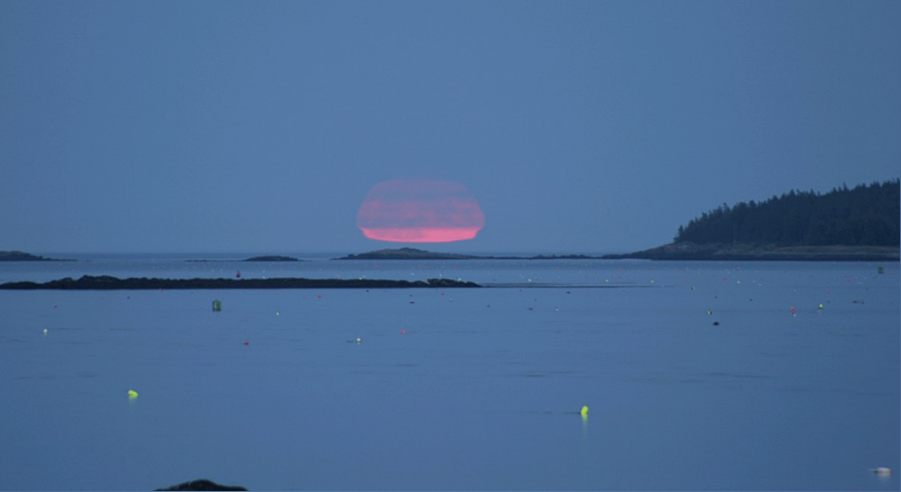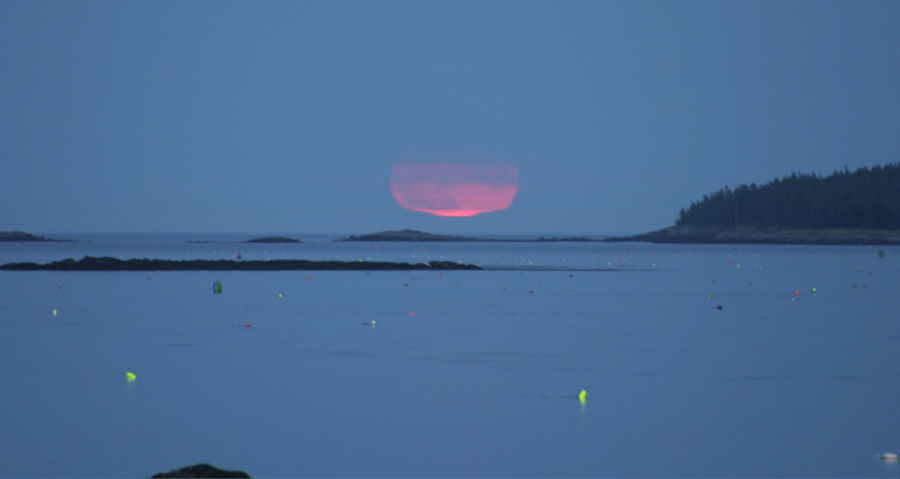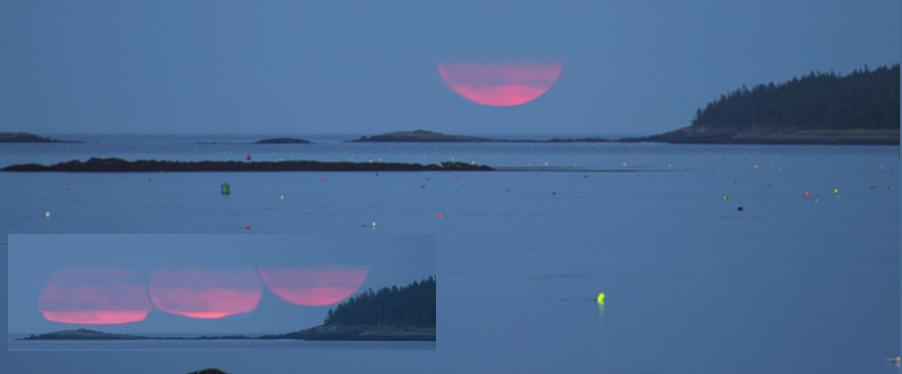Full Moon Mirage
Full Moon Mirage: A Phenomenon Worth Noticing
When it comes to atmospheric optics, the focus is often on solar phenomena like rainbows and halos. However, moonrise and moonset mirages are equally captivating and should not be overlooked. These mirages occur when the full moon rises or sets through a strong temperature inversion, where cooler air lies beneath warmer air. The result is a distorted and flattened image of the moon, accompanied by layers of haze or mist that further obscure its appearance.
The Influence of Temperature Inversion
In the case of the full moon mirage, the cool air responsible for the distortion is likely in contact with a cold ocean. As the moonlight passes through this inversion layer, it undergoes strong refraction, causing the moon to appear highly flattened. Above this distorted segment, there is an undisturbed portion of the moon, although even this image may suffer as it becomes progressively obscured by a layer of haze or mist.
Lesser-Known Mirages
Moonrise and moonset mirages may not receive as much attention as their solar counterparts, but they are no less fascinating. While solar mirages like Fata Morgana or inferior mirages are more commonly observed, full moon mirages offer a unique spectacle for those who take the time to notice them. These mirages can be seen during certain atmospheric conditions, particularly when a temperature inversion is present.
The Beauty of Full Moon Mirages
The distorted and flattened appearance of the moon during a full moon mirage creates a visually stunning sight. The normally round and luminous orb transforms into a stretched and elongated shape, reminiscent of a lunar slice. The reddened hue of the moon during this phenomenon adds to its allure, creating a surreal atmosphere against the backdrop of the night sky.
Observing Full Moon Mirages
To witness a full moon mirage, it is important to be in the right place at the right time. Coastal areas, where temperature inversions are more likely to occur due to contact with colder ocean air, provide optimal viewing conditions. Additionally, clear and calm nights with minimal atmospheric disturbance are ideal for spotting these mirages. Patience and a keen eye are essential when trying to capture the fleeting beauty of a full moon mirage.
The Science Behind the Mirage
Understanding the science behind full moon mirages can enhance the appreciation of this phenomenon. Temperature inversions occur when there is a reversal in the normal atmospheric temperature profile. Instead of warmer air near the surface and cooler air higher up, a temperature inversion results in cooler air beneath warmer air. This inversion causes light to refract differently, leading to the distortion and flattening of the moon's image during a full moon mirage.
The Role of Haze and Mist
In addition to temperature inversions, layers of haze or mist can further contribute to the captivating nature of full moon mirages. These atmospheric particles scatter and absorb light, causing a reduction in visibility and adding a mystical quality to the moon's appearance. The gradual obscuring of the moon's image as it rises or sets through these layers creates an ethereal and dreamlike effect.
Capturing the Magic
For photographers and enthusiasts, capturing the magic of a full moon mirage can be a rewarding challenge. To photograph these mirages successfully, it is crucial to have the right equipment, including a sturdy tripod and a telephoto lens. Finding a vantage point that offers an unobstructed view of the horizon is also important. Patience is key, as full moon mirages can be elusive and require careful timing to capture their fleeting beauty.
A Reminder of Nature's Wonders
Full moon mirages serve as a reminder of the awe-inspiring phenomena that occur in our natural world. They offer a glimpse into the complexity and beauty of atmospheric optics, showcasing the interplay between light, temperature, and atmospheric conditions. By appreciating and studying these mirages, we deepen our understanding of the Earth's atmosphere and the incredible displays it can produce.
Conclusion
While solar phenomena often steal the spotlight in discussions of atmospheric optics, full moon mirages deserve recognition for their captivating beauty. These mirages, occurring during moonrise or moonset through temperature inversions, offer a unique and enchanting spectacle. With their distorted and flattened appearance, accompanied by layers of haze or mist, full moon mirages remind us of the wonder and complexity of our natural world. So, the next time you find yourself under a clear night sky during a full moon, take a moment to look closely—there may be a mesmerizing mirage waiting to be discovered.

Full Moon Rising ~ Bill Belko caught this strangely distorted moonrise over the ocean at Jonesport, Maine. More of it below. ©Bill Belko, shown with permission.

The highly reddened full moon is rising through a strong temperature inversion - loosely speaking, unusually cooler air beneath warmer. The cool air was probably a result of contact with the cold ocean. Within the inversion the moonlight is strongly refracted to form a highly flattened lunar slice. Above that is an undistorted segment but even that image suffers as its top is progressively obscured by a layer of haze or mist.
Moonrise and moonset mirages are less noticed than their brighter solar counterparts but there are plenty of them. Click the thumbnails.

Note: this article has been automatically converted from the old site and may not appear as intended. You can find the original article here.
Reference Atmospheric Optics
If you use any of the definitions, information, or data presented on Atmospheric Optics, please copy the link or reference below to properly credit us as the reference source. Thank you!
-
<a href="https://atoptics.co.uk/blog/full-moon-mirage/">Full Moon Mirage</a>
-
"Full Moon Mirage". Atmospheric Optics. Accessed on December 21, 2024. https://atoptics.co.uk/blog/full-moon-mirage/.
-
"Full Moon Mirage". Atmospheric Optics, https://atoptics.co.uk/blog/full-moon-mirage/. Accessed 21 December, 2024
-
Full Moon Mirage. Atmospheric Optics. Retrieved from https://atoptics.co.uk/blog/full-moon-mirage/.